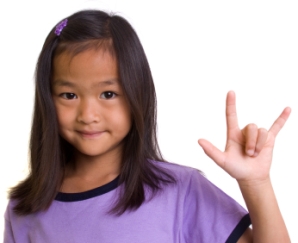Language Door has provided classes in dozens of languages to students from all over the West Hills area. Our focus is on small group classes to maximize the interaction between students and teachers. We also offer private lessons, translations, interpreting services, and corporate classes.
Interesting Facts About ASL American Sign Language
- As many as 500,000 people in the U.S. communicate using ASL.
- An important milestone in the history of education for deaf’ people was the founding of Gallaudet College, in Washington, D.C. in 1864, which remains the only liberal arts college for deaf’ people in the United States and the world.
- ASL is considered a foreign language.
Countries Where ASL American Sign Language Is Used
American Sign Language (ASL) is the third most widely used language in the U.S., after English and Spanish. A form of ASL has been used in the U.S. for over two hundred years. While it seems like sign language might be universally recognized, different sign languages are used in different countries or regions. ASL is widely learned as a second language, serving as a lingua franca, and a number of closely related sign languages derived from ASL are used in many different countries
Learn to Speak ASL with Language Door Today!
Los Angeles Language Door’s expert teachers offer instruction for students of all ages. We keep our tuition prices low but offer quality instruction in a pleasant environment.Class size is small to maximize the interaction between students and teachers. Our teachers are native speakers and offer the hands on training that will enhance your learning experience.  [xyz-ihs snippet=”languages”]
[xyz-ihs snippet=”languages”]
History Of Sign Language
It was in the sixteenth century that Geronimo Cardano, a physician of Padua, in northern Italy, proclaimed that deaf people could be taught to understand written combinations of symbols by associating them with the thing they represented. The first book on teaching sign language to deaf people that contained the manual alphabet was published in 1620 by Juan Pablo de Bonet. In 1755 Abbe Charles Michel de L’Epee of Paris founded the first free school for deaf people. He taught that deaf people could develop communication with themselves and the hearing world through a system of conventional gestures, hand signs, and fingerspelling. He created and demonstrated a language of signs whereby each would be a symbol that suggested the concept desired. America owes a tremendous debt of gratitude to Thomas Hopkins Gallaudet, an energetic Congregational minister who became interested in helping his neighbor’s young deaf daughter, Alice Cogswell. He traveled to Europe in 1815, when he was twenty-seven, to study methods of communicating with deaf people. While in England he met Abbe Roche Ambroise Sicard, who invited him to study at his school for deaf people in Paris. After several months Gallaudet returned to the United States with Laurent Clerc, a deaf sign language instructor from the Paris school. In 1817 Gallaudet founded the nation’s first school for deaf people, in Hartford, Connecticut, and Clerc became the United States’ first deaf sign language teacher. Soon schools for deaf people began to appear in several states. Among them was the New York School for the Deaf, which opened its doors in 1818. In 1820 a school was opened in Pennsylvania, and a total of twenty-two schools had been established throughout the United States by the year 1863. Today we are fortunate to have one of the most complete and expressive sign language systems of any country in the world. We owe much to the French sign system, from which many of our present-day signs, though modified, have been derived. Today’s ASL includes some elements of LSF plus the original local sign languages, which over the years have melded and changed into a rich, complex, and mature language. Modern ASL and modern LSF are distinct languages and, while they still contain some similar signs, can no longer be understood by each other’s users.

